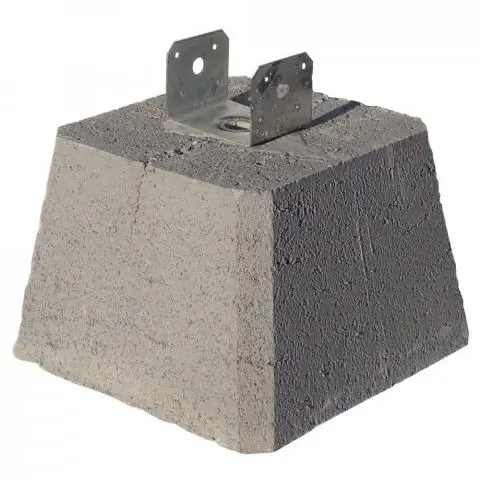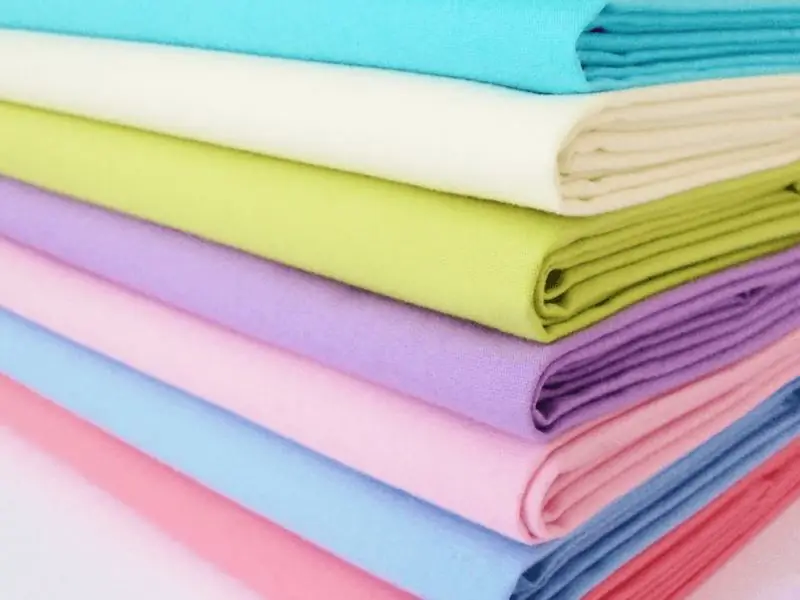
Table of contents:
- DIY pool filter
- Cleaning methods and types of pool filters
- Recommendations for the selection of materials and the selection of tools for creating your own filter
- Performing calculations and schemes
- DIY step-by-step guide to making a pool filter
- Nuances of operation
- How to chlorinate pool water yourself
- Author Bailey Albertson [email protected].
- Public 2023-12-17 12:53.
- Last modified 2025-06-01 07:32.
DIY pool filter

It's nice to plunge into the pool with clean and cool water on a hot day. The quality of the aquatic environment is negatively affected by multiplying bacteria, dust, plant spores, insects, leaves, as well as cosmetics, sweat and hair of those who swim in an artificial reservoir. After a short time, even perfectly clean water becomes cloudy, acquires a greenish tint and becomes saturated with microorganisms, if it is not regularly cleaned. It is problematic and expensive to frequently renew significant volumes of water. You can keep it clean with homemade filters and chlorine-containing components.
Content
-
1 Cleaning methods and types of pool filters
-
1.1 Pool cleaning methods
- 1.1.1 Chemical cleaning method
- 1.1.2 Mechanical cleaning
- 1.1.3 Combined cleaning method
-
1.2 Types of filters
- 1.2.1 Sand filters
- 1.2.2 Cartridge filters
- 1.2.3 Ground Filters
-
-
2 Recommendations for the selection of materials and the selection of tools for creating your own filter
- 2.1 Selection of filter materials
- 2.2 Tools required for the job
-
3 Performing calculations and schemes
3.1 Table: dependence of the time required for one cycle of water exchange on the parameters and loading of the pool
-
4 Step-by-step guide to making a pool filter with your own hands
4.1 Video: construction of a homemade sand filter
-
5 Nuances of operation
5.1 Changing the filler
- 6 How to chlorinate pool water yourself
Cleaning methods and types of pool filters
The division of filters for pools into types is carried out depending on the principle of operation and the substance used for cleaning.
Pool cleaning methods
The operation of the filter device is based on the following cleaning principles:
- chemical - disinfection of the aquatic environment is carried out using chemical reagents;
- mechanical - water is purified in the process of its circulation through the cleaning agent;
- combined - the sanitary indicators of water are achieved by combining the mechanical method of purification and the use of chemicals.
Chemical cleaning method
The main advantage of filters, the principle of which is based on a chemical method, is the effective purification of the aquatic environment from the development of microorganisms and bacteria harmful to human health.
The main disadvantages of chemical filters:
- Increased dimensions. The bulky design of the cleaning device requires additional floor space.
- The negative effect of chemical reagents on the human skin. The time spent by people in the pool is limited.
- The need to shower after swimming in the pool. Chemicals dissolved in the pool should be thoroughly washed off the skin.
Mechanical cleaning
The main advantages of filters that provide mechanical water purification include:
- compact dimensions;
- affordable price;
- effective purification of the aquatic environment.
The main disadvantage of mechanical filters is that they can only be used in small frame and inflatable pools.
Combined cleaning method
Filtration devices that combine mechanical cleaning and chemical disinfection are ideal for all types of swimming pools. In the process of water circulation through such a filter, foreign inclusions are simultaneously removed, as well as the destruction of microorganisms and bacteria. The increased cost of the filter limits its use for small suburban pools.
Filter types
Depending on the type of filler used to filter the aqueous medium, the devices are divided into types. To purify water in filters, it is used:
-
sand;

Sand Fractions of sand for filling the filter should be 0.4-1.4 mm in size
-
Earth;

Diatomite Earthen filler (diatomite) is a mixture of silica-rich fossil rocks
-
special cartridges.

Cartridges Filter cartridges vary in size and design
Sand filters
Filters in which water is purified with sand are widespread. Their main advantages:
- affordable price;
- simple construction.
A sand filter is a sealed container with sand through which water circulates.

Passing through an array of sand, water is purified and enters the pool
The sifted quartz sand filters out foreign inclusions larger than 20 microns. Considering the size of mechanical impurities settling in the sandy massif, these filters are used exclusively in pools with a small area, located in summer cottages and in private houses.
The weak side of sand filters - when it becomes clogged, it becomes necessary to organize a reverse flow of water to ensure effective filtration.
When choosing a sand filter filler, choose glass sand. It provides high-quality cleaning and has a long service life (up to 5 years). You can use quartz sand, which must be changed after 3 years.
Cartridge filters
A cartridge filter is a reservoir that contains replaceable cartridges. They are filled with a substance capable of filtering small particles up to five microns in size.

To replace the cartridge, simply unscrew the filter cover
Carbon, polyphosphate salt and other special substances are used as a cartridge filler. The filter is easy to operate, as its design allows quick replacement of cartridges. The affordable price of cartridge devices in comparison with earth filters allows maintaining the purity of water in private outdoor pools at low cost.
Ground Filters
The filter with earthen filler (diatomaceous earth) provides the highest degree of water purification and is designed for use in tanks with increased volume.

Externally, the earthen filter looks like a sand filter, but differs in filler
The filter element of the device contains an earthy mixture based on fossil rocks. Cleaning is carried out by passing water through the earth "cushion". The silica-rich filler effectively purifies water because:
- neutralizes compounds saturated with chlorine;
- prevents the development of bacteria and microorganisms;
- traps heavy metals;
- prevents the development of algae.
The disadvantages of filters with an earthen mixture include the high price and increased toxicity of the spent filler. For replacement, it is necessary to attract specialists. This limits the widespread use of ground filters.
Recommendations for the selection of materials and the selection of tools for creating your own filter
Sand filters are widely used for cleaning small private swimming pools. For self-production of such a filter, expensive materials and special tools are not required.
Selection of filter materials
To make a sand filter, prepare the following materials:
-
plastic container with a capacity of up to 50 liters with a round opening in the upper part;

Filter container A barrel with a lid is suitable for the filter.
- flexible corrugated or rubber hoses;
- metal or plastic clamps;
- adapters (branch pipes) for connection with hoses;
- filter element for preliminary purification of the aqueous medium;
- pressure gauge for pressure control in the filter tank;
- intake device with a protective grid;
- glue;
- small-sized pump with motor up to 200 W;
- sand used as filler.
Tools required for the job
To make a filter filled with sand, the following tools are required:
- electric drill with drills;
- pliers;
- set of wrenches;
- hacksaw for metal.
Performing calculations and schemes
To ensure high-quality purification of the aquatic environment, it is necessary to first develop a filter connection diagram and calculate the intensity of water circulation provided by the pump. You can independently develop a connection option or use a typical scheme.

A typical scheme provides for the connection of the necessary equipment and communications
The filter capacity, equal to the pump capacity, is determined by the formula Q = V / T, where V is the tank capacity, and T is the duration of the water exchange cycle (up to 5 hours is recommended). If it is necessary to clean a pool with a water volume of 25 m 3, the productivity of the filtering system will be 5 m 3 / hour (25 m 3: 5 hours = 5 m 3 / hour). If the filtration unit is operated throughout the day, the total volume of purified water will be 120 m 3 (5 m 3 / hour x 24 hours). This will provide the required five-fold water purification throughout the day.
For small pools it is not always advisable to filter the water around the clock. It is enough to turn on the pump every day for 5-10 hours. For this, it is necessary to choose the right performance. For example, if in a small frame pool with a volume of 25 m 3 the pump will supply water to the filter for 10 hours, then for five water exchange it is necessary to pump the entire volume of water through the filter 5 times in 10 hours. Total, 25 m 3 x5 = 125 m 3. To accomplish this task, the pump capacity must be 12.5 m 3 / h (125 m 3: 10 h = 12.5 m 3/hour). This will allow operating the filtering unit for a shorter time, providing the necessary circulation intensity to purify water from impurities.

The more people swim in the pool, the more often water exchange should be performed.
Table: the dependence of the time required for one cycle of water exchange, on the parameters and loading of the pool
| Number of swimmers during the day | Pool capacity, m 3 | ||
| less than 30 | 30-50 | more than 50 | |
| 1-3 | T = 5 hours | T = 6 hours | T = 7 hours |
| 4-5 | T = 4 hours | T = 5 hours | T = 6 hours |
| 6 and more | T = 3 hours | T = 4 hours | T = 5 hours |
DIY step-by-step guide to making a pool filter
When making a sand filter, follow the diagram of the device.

Pre-designed filter layout will facilitate fabrication
The sand filter is manufactured in stages:
-
Sift the sand on a sieve, ensuring the particle size is 0.5-1.4 mm.

Sifting sand The size of the filter sand is determined by the mesh size of the sieve
-
Clean the sand from dust and large inclusions by rinsing it with warm water.

Sand washing The sand for the filter is washed until it is completely cleaned of dust
- Boil the sand filled with water in a large container to remove bacteria.
-
Drill holes in the plastic container for connecting the inlet and outlet lines.

Top hole The hole for the inlet line is located at the top of the barrel
-
Fix the hose connections with glue.

Installation of branch pipes The glue reliably seals the pipes entering the filter
- Install the protective grid and filter element inside the plastic tank.
-
Fill the container with sand, serving it at the same time as water.

Filter sand Filling the filter with sand and water allows the filling to be compacted
-
Connect the top filter connection to the flow line.

Filter connection It is convenient to use a flexible hose to connect the filter
- Connect the bottom outlet to the hose to the pump.
-
Install the gauge, check for correct connections and firmly fasten the cover to the top of the housing.

Connecting the filter to the pump All lines must be connected according to the diagram
Video: construction of a homemade sand filter
Nuances of operation
When purifying water with a self-made sand filter, you must comply with safety requirements and deal with all the intricacies of its work. The following actions must be performed periodically:
- control the readings of the manometer, which informs about the change in pressure inside the tank. When the normal pressure rises from 0.8 to 1.3 bar, the device needs a backwash;
- open the filter with the pump off. This will avoid the ingress of small particles and dirty water on the mucous membrane;
- connect the device, keeping a distance of one meter from the walls of the pool. To service the filter, provide free space;
- remove after six months of operation lime deposits inside the filter. Use a special composition for descaling;
-
replace the filler once every two years. During operation, the sand gradually hardens, saturated with dirt and compacted, which complicates filtration;

Dirty sand filter Dirty and hardened sand cannot provide good filtration
- ensure the maximum removal of the suction and delivery lines. This will improve water circulation.
Filler replacement
Perform measures for replacing the filler according to the following algorithm:
- Disconnect the filter device.
- Open the filter cover.
- Remove the sand mass using a technical vacuum cleaner.
- Flush the pipes and the inside of the filter.
- Fill the filter housing with fresh sand. Pour the coarse fraction on the bottom and add fine sand on top.
How to chlorinate pool water yourself
The choice and amount of chlorinating agent depends on the temperature of the water and the environment, as well as the pollution level of the pool.
To ensure effective water treatment with chlorine, it is necessary to control the pH value. It is advisable to dissolve chlorine (according to the recommendations of the manufacturers of chlorine-containing preparations) at a pH value of more than 7 and less than 7.5.

PH control is essential for proper chlorination of water
With an increase in the pH value, the consumption of chlorinating compounds or tablets increases. This produces a characteristic unpleasant odor.
Each time the pool is filled during the season, it is imperative to shock the water with the help of instant preparations. A month later, repeated disinfection is carried out. Increasing the chlorine concentration during shock treatment kills microorganisms and neutralizes algae growth.
After chlorination, the filter must be cleaned and the pH value checked with a tester. An indicator of the quality of water containing chlorine is the concentration of the substance in the range of 0.3-0.5 mg / l and the pH level from 7 to 7.5.
Having familiarized yourself with the methods of water purification, it is not difficult to independently manufacture a filter unit for an individual pool and ensure its correct operation. By using available materials, a standard set of tools can be used to create an effective filtration system at a low cost and ensure that the sanitary requirements for swimming pools are met.
Recommended:
Making A Pool From Polypropylene With Your Own Hands + Photos And Videos

A step-by-step description of building a pool and making a polypropylene bowl with your own hands. Features of the material, calculations, the necessary tools. Video
How To Make A Pool In A Bathhouse With Your Own Hands - Step By Step Instructions With Photos, Videos And Drawings

Description of the types of swimming pools for a bath, their advantages and disadvantages. Detailed instructions for arranging yourself with drawings
How To Choose And Build A Foundation For A Bath With Your Own Hands - 4x6, 3x4 And Other Sizes, Tips, Instructions, Photos And Videos

How to make a foundation for a bath with your own hands. Types and features of foundations. The choice of materials and technology, installation rules and step-by-step instructions
How To Make A Slime At Home With Your Own Hands - Without Sodium Tetraborate And Glue, From Hand Cream, Shaving Foam And Other Ingredients, Recipes With Photos And Videos

Is it possible to make a slime at home. Types of slimes and recipes for their manufacture, depending on the desired properties. Toy care features
How To Sew Diapers For A Newborn With Your Own Hands - A Cocoon, With Velcro, Zippers And Other Options: Sizes, Patterns And Useful Tips

What kind of diapers is needed for a baby in the first months of life, detailed MC for their manufacture, help in choosing a material, tips and videos
